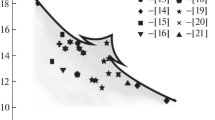Conclusions
The addition of titanium dioxide considerably reduces the sintering point of alumina and zirconia-alumina mixtures. Titanium dioxide does not have this effect on the sintering of the ternary equimolecular mixture ZrO2∶MgO∶ Al2O3. But the zero porosity was not even attained during firing up to 1700°. When the three-component mixture ZrO2 + MgO + Al2O3 was sintered, spinel formed first, after which, at a higher temperature, there formed a solid solution ZrO2 and MgO. In the presence of titanium dioxide some of the magnesium oxide apparently forms magnesium titanate with the TiO2, and this impairs the stabilization of the zirconium dioxide, in view of which it is partially detected in monoclinic form in the fired mixtures. The addition of 2% TiO2 reduces the temperature of polymorphous transitions of ZrO2 by approximately 200°.
Specimens of the composition 90% Al2O3 + 10% ZrO2 and ZrO2∶MgO∶Al2O3=1∶1∶1 show better spalling resistance than those made of alumina and those made of zirconium dioxide stabilized with magnesium or calcium oxide.
Pure pre-synthesized spinel does not react with zirconium dioxide when fired up to 1600°, nor with titanium dioxide up to 1500°.
The coefficient of thermal linear expansion of the equimolecular mixtures ZrO2-MgO-Al2O3 and ZrO2-CaO-Al2O3 is considerably lower than that of the corresponding mixtures without alumina.
When the three component equimolecular mixtures ZrO2-CaO-Al2O3 is sintered, calcium aluminate and the solid solution ZrO2-CaO are formed.
The two-component compositions Al2O3-ZrO2 and three-component MgO-Al2O3-ZrO2 have high refractoriness, satisfactory spalltng resistance, good stability-underload at high temperatures, and can be used as super duty refractories.
Similar content being viewed by others
Bibliography
W. O. Smothers, H. I. Reynolds. Journ. Amer. Cer. Soc., 1954, v. 37, No. 12, 558.
D. N. Poluboyarniov and V. L. Balkevich. Ogneupory, 1951, No. 3.
P. P. Budnikov and K. M. Shmulker. Journal of Applied Chemistry, 1946, No. 10.
V. A. Bron. Ogneupory, 1951, No. 7.
D. N. Polyboyarniov. Ogneupory, 1953, No. 6.
E. K. Keller and A. B. Andreyeva. Ogneupory. 1958. No. 12.
P. Z. Ehrlich. Elektrochemie, v. 45, 1939.
K. M. Fedot'yev and D. A. Bogman. Proc. Second Conference on Experimental Mineralogy and Petrography, 1937.
Q. Huttig, D. Zinker and others. Elektrochemie, v. 40, 1934.
I. Ya. Sal'dau and N. A. Zhirnova. Academy of Sciences Herald. Chemical sciences section. 1945, No. 6.
R. F. Mather. Journ. Amer. Cer. Soc., 1942, v. 25, No. 3.
E. K. Keller and A. B. Andreyeva. Ogneupory, 1957, No. 2.
Author information
Authors and Affiliations
Rights and permissions
About this article
Cite this article
Keller, E.K., Andreyeva, A.B. Effect of titanium dioxide on sintering and stabilization of ZrO2 in zirconium-alumina and spinel-zirconium mixtures. Refractories 2, 19–26 (1961). https://doi.org/10.1007/BF01293089
Issue Date:
DOI: https://doi.org/10.1007/BF01293089




